Sika Deer
| Sika Deer |
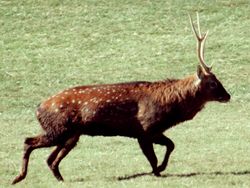 |
| Male (Stag or Hart) |
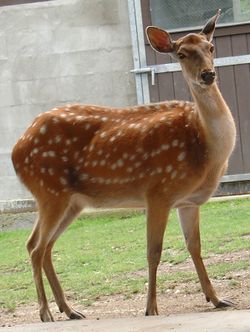 |
| Female (Hind) |
| Conservation status |

Least Concern (IUCN 3.1)[1] |
| Scientific classification |
| Kingdom: |
Animalia |
| Phylum: |
Chordata |
| Class: |
Mammalia |
| Order: |
Artiodactyla |
| Family: |
Cervidae |
| Subfamily: |
Cervinae |
| Genus: |
Cervus |
| Species: |
C. nippon |
| Binomial name |
Cervus nippon
Temminck, 1838 |
| Subspecies |
|
C. n. aplodontus
C. n. dybowskii
C. n. grassianus
C. n. keramae
C. n. kopschi
C. n. mandarinus
C. n. mantchuricus
C. n. pseudaxis
C. n. pulchellus
C. n. sichuanicus
C. n. taioanus
C. n. yesoensis
|
The Sika Deer, also known as the Spotted Deer or the Japanese Deer (Cervus nippon) is a species of deer that is native to much of East Asia, and also introduced to various parts of the world. It was previously found from Vietnam to the south and Russia to the north. Their name comes from "shika" (鹿), the Japanese word for "deer". The sika deer is not to be confused with the sitka deer, which is a subspecies of the mule deer, a distantly related species.
Taxonomy
The sika deer is a member of the genus Cervus, a group of deer also known as the "true deer". Cervus was formerly a large genus consisting of 12 species, but recent genetic studies discovered that the species are more distantly related to each other than previously thought, and 8 species and 3 genera split out. The sika deer, along with the elk, red deer, and central asian red deer, remained in the genus Cervus, with the white-lipped deer of genus Przewalskium being closely related.
Subspecies
There has been serious genetic pollution in many populations, especially Japan. Therefore the status of many subspecies remain uncertain. This is just one of the many different lists of the sika deer's subspecies.
- aplodontus: found in Northern Honshu
- grassianus: Shanxi, China
- keramae: Ryukyu Islands
- kopschi: Southern China
- mandarinus: Northern and Northeastern China
- mantchuricus: Northeastern China, Korea, and Russian Far East.
- nippon: found in Southern Honshu, Shikoku, and Kyushu
- pseudaxis: Northern Vietnam
- pulchellus: Tsushima Island
- sichuanicus: Western China.
- taioanus: Taiwan
- yesoensis: Hokkaido
Description
The Sika deer is one of the few deer species that does not lose its spots with maturity. Spot patterns are associated with region, or habitat. Mainland Asian Sika Deer have larger and more obvious spots. Taiwanese along with some Japanese populations have nearly invisible spots.
Sika deer range in color from mahogany to black, rarely white. They are medium sized herbivores, 50 – 95 cm tall at the shoulder, and weighing 30 – 70 kg. Males are noticeably larger than females. All sikas are compact and dainty-legged with short, trim, wedge-shaped heads and a boisterous disposition. When alarmed, they will often display a distinctive flared rump much like the American elk.
Sika stags have stout, upright antlers with an extra buttress up from the brow tine and a very thick wall. A forward-facing intermediate tine breaks the line to the top, which is usually forked. Occasionally, sika develop some palmation. Females carry a pair of distinctive black bumps on the forehead. Antler length can range from 11 to 19 inches to better than 30 inches depending on the subspecies. Stags also sport a distinctive mane while in the rut.
Behavior
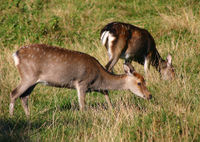
Sika deer grazing
In areas without human disturbance, sika deers can be active for the entire waking day. Lifestyles vary between individuals, with some occurring alone while others are found in single-sex groups. Large herds will gather in autumn and winter. The sika deer is a highly vocal species, with over 10 individual sounds ranging from soft whistles to loud screams.
Sika males are territorial and keep harems of females during the rut, which peaks from early September through October but may last well into the winter months. Territory size varies with type of habitat and size of the buck; strong, prime bucks may hold up to 2 ha. Territories are marked with a series of shallow pits, called "scrapes," into which the males urinate and from which emanates a strong, musky odor. Fights between rival males are sometimes fierce, long, and may even be fatal.
Range and Habitat
Sika deers previously had a wide distribution across East Asia from Vietnam to Russian Far East. Today their range is heavily reduced and fragmented in all areas except Japan, where the species remain common. It is extinct from Vietnam and Korea, and in China it is limited to 2 or 3 small wild populations in the Southern part of the country. There are many so called wild populations of sika deer in China, which are actually descended from escaped domesticated deers. In Russia the species is only found in Primorsky Krai.
Sika deer are found in the temperate/subtropical forests of Eastern Asia, preferring areas with dense understory, and where snowfall does not exceed 10–20 cm. They tend to forage in patchy clearings of forests. Introduced populations are found in areas with similar habitats to their native range, including Western and Central Europe, Eastern United States, and New Zealand.
Status
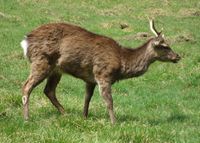
Formosan Sika Deer.
The sika deer inhabits the temperate and subtropical woodlands, which unfortunately are also the perfect habitats for farming and human exploitation. The sika deers are found in one of the most densely populated areas in the world, and where forests were cleared away hundreds of years ago. The population status of sika deers differs significantly from the countries they are found in, due to the views of the species by people.
Japan has the largest native sika populations in the world. There are over hundreds of thousands sika deers in the wild and the numbers are still increasing. This is mainly due to the recent conservation efforts and the extinction of wolves, its main predator, from the country. Without its main enemy the population of sika deers boomed and is now overpopulated in many areas, posing a threat to both forests and farmlands. Hunting is now encouraged in Japan.
China used to have the largest population of sika deers, but thousands of years of hunting and forest logging has reduced the population to less than 1,000. Only 2 of the 5 subspecies remain, each existing in single populations of a couple hundred individuals. The other three subspecies still remain in farms and zoos, but the lack of decent habitats in the region have made reintroduction impossible.
The species was previously extinct in Taiwan, but individuals from zoos was introduced in Kenting National Park and the population now numbers 200. Reintroduction programs are also underway in Vietnam, where the species is currently extinct.
Russia has a relatively large and stable population of 9,000, but it is limited to a small area in Primorsky Krai.
The species is likely to be extinct in Korea, but unconfirmed sightings are frequent from the northeastern mountains of North Korea, possibly having migrated from Russia.
Introduced populations
Sika Deer have been introduced into a number of other countries including Australia, Austria, Denmark, Germany, Britain, France, Ireland, Jolo Island (southern Philippines), New Zealand, Poland, Morocco and the United States (Maryland, Texas, Wisconsin, Virginia, and Kansas). In many cases they were originally introduced as ornamental animals in parkland, but have established themselves in the wild.
In Britain and Ireland several distinct feral populations now exist. Some of these are in isolated areas, for example on the island of Lundy, but others are contiguous with populations of the native Red Deer. Since the two species sometimes hybridise, there is a serious conservation concern.[2] In research which rated the negative impact of alien mammals in Europe, the sika deer was found to be among the most damaging to the environment and economy along with the Brown rat and Muskrat.[3]
In the 1900s, King Edward VII presented a pair of sika deer (Cervus nippon) to John, the second Baron Montagu of Beaulieu. This pair escaped into Sowley Wood and were the basis of the large herds of sika to be found in the New Forest today. They were so prolific that culling had to be introduced in the 1930s to control numbers.[4]
Hunting

Sika deer in winter
Across its original range, and more intensively in many countries to which it has been introduced, the sika is regarded as a particularly prized and elusive sportsman's quarry. In Britain, Ireland and mainland Europe it has been noted that sika display very different survival strategies and escape tactics from the indigenous deer. They have a marked tendency to use camouflage and concealment in circumstances when Red deer, for example, would flee; and have been seen to squat and lie belly-flat when danger threatens in the form of human intrusion.
Hunters and control cullers have estimated that the sika's wariness and "cleverness" makes it three or four times more difficult to bring to bag than a Red or Fallow deer. It has also been widely remarked that sika are much more tenacious of life, and harder to kill with a rifle bullet, than the native deer of Europe and North America. In the British Isles sika are widely regarded as a very serious threat to new and established woodlands, and public and private forestry bodies adopt policies of rigorous year-round culling, generally with little effect.
Antler trade
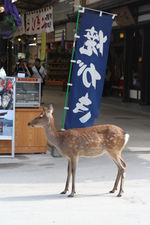
Tame deer wandering the streets of Miyajima, Japan
Sika Deer in China had been domesticated long ago for the antler trade, along with several other species. In Taiwan, both Formosan Sika Deer and Formosan Sambar Deer (Cervus unicolor swinhoei) have been farmed for velvet antlers. The only exceptions that may have integrity as a subspecies are possibly the Dybowski's Sika deer of Manchuria and Ussuri region, and the sika deer subspecies that survive in Japan, Ryukyu Islands, and Taiwan. Japan is the only country in Eastern Asia where sika deer were not farmed for velvet antler.
Other deer raised for the antler trade were Thorold's Deer (Cervus albirostris), various Central Asian Red Deer (Cervus affinis) subspecies, and Wapiti (Cervus canadensis) subspecies.
See also
- Red Deer - European Red Deer
- Central Asian Red Deer - Asian/Himalayan/Tibetan Red Deer
- Elk - East Asian/North American Red Deer (Wapiti)
- Thorold's Deer
References
- "Cervus nippon". Integrated Taxonomic Information System. http://www.itis.gov/servlet/SingleRpt/SingleRpt?search_topic=TSN&search_value=180696. Retrieved 10 February 2006.
- Igota, H., Sakagura, M., Uno, H., Kaji, K., Maneko, M., Akamatsu, R., & Maekawa, (in press). Seasonal patterns of female sika deer in eastern Hokkaidō, Japan. Ecological Research, 19.
Further reading
O'Brien, D.J., Roodey, S.M. and Hayden, T.J. 2009. A differential vulnerability to hunting between the sexes in Sika-type calves. I. Nat. J. 30: 7- 9.
External links
|
Extant Artiodactyla species |
|
| Kingdom: Animalia · Phylum: Chordata · Class: Mammalia · Infraclass: Eutheria · Superorder: Laurasiatheria |
|
|
Suborder Ruminantia |
|
| Antilocapridae |
|
|
| Giraffidae |
|
|
| Moschidae |
|
Moschus
|
Himalayan Musk Deer (M. chrysogaster) · Siberian Musk Deer (M. moschiferus) · Dwarf Musk Deer (M. berezovskii) · Black Musk Deer (M. fuscus)
|
|
|
| Tragulidae |
|
Hyemoschus
|
Water Chevrotain (H. aquaticus)
|
|
|
Moschiola
|
Indian Spotted Chevrotain (M. indica) · Yellow-striped Chevrotain (M. kathygre) · Sri Lankan Spotted Chevrotain (M. meminna)
|
|
|
Tragulus
|
Java Mouse-deer (T. javanicus) · Lesser Mouse-deer (T. kanchil) · Greater Mouse-deer (T. napu) · Philippine Mouse-deer (T. nigricans) · Vietnam Mouse-deer (T. versicolor) · Williamson's Mouse-deer (T. williamsoni)
|
|
|
| Cervidae |
Large family listed below
|
|
| Bovidae |
Large family listed below
|
|
|
|
|
Family Cervidae |
|
| Muntiacinae |
|
Muntiacus
|
Indian Muntjac (M. muntjak) · Reeves's Muntjac (M. reevesi) · Hairy-fronted Muntjac (M. crinifrons) · Fea's Muntjac (M. feae) · Bornean Yellow Muntjac (M. atherodes) · Roosevelt's muntjac (M. rooseveltorum) · Gongshan muntjac (M. gongshanensis) · Giant Muntjac (M. vuquangensis) · Truong Son Muntjac (M. truongsonensis) · Leaf muntjac (M. putaoensis)
|
|
|
Elaphodus
|
Tufted deer (E. cephalophus)
|
|
|
| Cervinae |
|
Cervus
|
Red Deer (C. elaphus) · Elk (C. canadensis) · Thorold's deer ( C. albirostris) · Sika Deer ( C. nippon) · Barasingha ( C. duvaucelii) · Eld's Deer ( C. eldii) · Sambar Deer ( C. unicolor) · Rusa Deer ( C. timorensis) · Philippine Sambar ( C. mariannus) · Philippine Spotted Deer ( C. alfredi)
|
|
|
Axis
|
Chital (A. axis) · Hog deer ( A. porcinus) · Calamian Deer ( A. calamianensis) · Bawean Deer ( A. kuhlii)
|
|
|
Elaphurus
|
Père David's Deer (E. davidianus)
|
|
|
Dama
|
|
|
|
| Hydropotinae |
|
Hydropotes
|
Water deer (H. inermis)
|
|
|
| Capreolinae |
|
Odocoileus
|
|
|
|
Blastocerus
|
Marsh Deer (B. dichotomus)
|
|
|
Ozotoceros
|
Pampas deer (O. bezoarticus)
|
|
|
Mazama
|
Red Brocket (M. americana) · Small Red Brocket (M. bororo) · Merida Brocket (M. bricenii) · Dwarf Brocket (M. chunyi) · Gray Brocket (M. gouazoubira) · Pygmy Brocket (M. nana) · Amazonian Brown Brocket (M. nemorivaga) · Yucatan Brown Brocket (M. pandora) · Little Red Brocket (M. rufina) · Central American Red Brocket (M. temama)
|
|
|
|
|
|
|
Hippocamelus
|
Taruca (H. antisensis) · South Andean Deer (H. bisulcus)
|
|
|
Capreolus
|
Roe Deer (C. capreolus) · Siberian Roe Deer (C. pygargus)
|
|
|
|
|
|
|
|
|
|
|
|
|
|
Family Bovidae |
|
| Cephalophinae |
|
Cephalophus
|
Abbott's Duiker (C. spadix) · Aders' Duiker (C. adersi) · Bay Duiker (C. dorsalis) · Black Duiker (C. niger) · Black-fronted Duiker (C. nigrifrons) · Blue Duiker (C. monticola) · Harvey's Duiker (C. harveyi) · Jentink's Duiker (C. jentinki) · Maxwell's Duiker (C. maxwellii) · Red Forest Duiker (C. natalensis) · Ogilby's Duiker (C. ogilbyi) · Peters's Duiker (C. callipygus) · Red-flanked Duiker (C. rufilatus) · Ruwenzori Duiker (C. rubidis) · Weyns's Duiker (C. weynsi) · White-bellied Duiker (C. leucogaster) · Yellow-backed Duiker (C. Sylvicultor) · Zebra Duiker (C. zebra)
|
|
|
Sylvicapra
|
Common Duiker (S. grimmia)
|
|
|
| Hippotraginae |
|
Hippotragus
|
Roan Antelope (H. equinus) · Sable Antelope (H. niger)
|
|
|
Oryx
|
East African Oryx ( O. beisa) · Scimitar Oryx ( O. dammah) · Gemsbok (O. gazella) · Arabian Oryx ( O. leucoryx) |
|
|
Addax
|
Addax (A. nasomaculatus)
|
|
|
| Reduncinae |
|
Kobus
|
Upemba Lechwe (K. anselli) · Waterbuck (K. ellipsiprymnus) · Kob (K. kob) · Lechwe (K. leche) · Nile Lechwe (K. megaceros) · Puku (K. vardonii)
|
|
|
Redunca
|
Southern Reedbuck (R. arundinum) · Mountain Reedbuck (R. fulvorufula) · Bohor Reedbuck (R. redunca)
|
|
|
| Aepycerotinae |
|
|
| Peleinae |
|
Pelea
|
Grey Rhebok (P. capreolus)
|
|
|
| Alcelaphinae |
|
Beatragus
|
Hirola (B. hunteri)
|
|
|
Damaliscus
|
Korrigum (D. korrigum) · Common Tsessebe (D. lunatus) · Bontebok (D. pygargus) · Bangweulu Tsessebe (D. superstes)
|
|
|
Alcelaphus
|
Hartebeest (A. buselaphus) · Red Hartebeest (A. caama) · Lichtenstein's Hartebeest (A. lichtensteinii)
|
|
|
|
|
|
|
| Pantholopinae |
|
Pantholops
|
Tibetan antelope (P. hodgsonii)
|
|
|
| Caprinae |
Large subfamily listed below
|
|
| Bovinae |
Large subfamily listed below
|
|
| Antilopinae |
Large subfamily listed below
|
|
|
|
|
Family Bovidae (subfamily Caprinae) |
|
|
Ammotragus
|
Barbary Sheep (A. lervia)
|
|
|
Budorcas
|
Takin (B. taxicolor)
|
|
|
|
Wild goat ( C. aegagrus) · West Caucasian Tur ( C. caucasia) · East Caucasian Tur ( C. cylindricornis) · Markhor (C. falconeri) · Alpine Ibex ( C. ibex) · Nubian Ibex ( C. nubiana) · Spanish Ibex ( C. pyrenaica) · Siberian Ibex ( C. sibirica) · Walia Ibex ( C. walie) |
|
|
Hemitragus
|
Nilgiri Tahr (H. hylocrius) · Arabian Tahr (H. jayakari) · Himalayan Tahr (H. jemlahicus)
|
|
|
Naemorhedus
|
Red Goral (N. baileyi) · Japanese Serow (N. crispus) · Long-tailed Goral (N. caudatus) · Gray Goral (N. goral) · Mainland Serow (N. sumatraensis) · Taiwan Serow (N. swinhoei)
|
|
|
Oreamnos
|
Mountain goat (O. americanus)
|
|
|
|
|
|
|
Ovis
|
|
|
|
Pseudois
|
Bharal (P. nayaur) · Dwarf Blue Sheep (P. schaeferi)
|
|
|
Rupicapra
|
|
|
|
|
|
Family Bovidae (subfamily Bovinae) |
|
| Boselaphini |
|
Tetracerus
|
Four-horned Antelope (T. quadricornis)
|
|
|
|
|
|
|
| Bovini |
|
Bubalus
|
|
|
|
Bos
|
|
|
|
Pseudonovibos
|
Kting Voar (P. spiralis)
|
|
|
Pseudoryx
|
Saola (P. nghetinhensis)
|
|
|
|
|
|
|
|
|
|
|
| Strepsicerotini |
|
Tragelaphus
|
|
|
|
Taurotragus
|
Common Eland (T. oryx) · Giant Eland (T. derbianus)
|
|
|
|
|
|
Family Bovidae (subfamily Antilopinae) |
|
| Antilopini |
|
Ammodorcas
|
Dibatag (A. clarkei)
|
|
|
|
|
|
|
Antilope
|
Blackbuck (A. cervicapra)
|
|
|
|
Mountain Gazelle (G. gazella) · Neumann's Gazelle (G. erlangeri) · Speke's Gazelle (G. spekei) · Dorcas Gazelle (G. dorcas) · Saudi Gazelle (G. saudiya) · Chinkara (G. bennettii) · Thomson's Gazelle (G. thomsonii) · Red-fronted Gazelle (G. rufifrons) · Dama Gazelle (G. dama) · Grant's Gazelle (G. granti) · Soemmerring's Gazelle (G. soemmerringii) · Cuvier's Gazelle (G. cuvieri) · Rhim Gazelle (G. leptoceros) · Goitered Gazelle (G. subgutturosa)
|
|
|
Litocranius
|
Gerenuk (L. walleri)
|
|
|
Procapra
|
Mongolian gazelle (P. gutturosa) · Goa (P. picticaudata) · Przewalski's Gazelle (P. przewalskii)
|
|
|
| Saigini |
|
Pantholops
|
Tibetan antelope (P. hodgsonii)
|
|
|
Saiga
|
Saiga Antelope (S. tatarica)
|
|
|
| Neotragini |
|
Dorcatragus
|
Beira (D. megalotis)
|
|
|
Madoqua
|
Günther's Dik-dik (M. guentheri) · Kirk's Dik-dik (M. kirkii) · Silver Dik-dik (M. piacentinii) · Salt's Dik-dik (M. saltiana)
|
|
|
Neotragus
|
Bates's Pygmy Antelope (N. batesi) · Suni (N. moschatus) · Royal Antelope (N. pygmaeus)
|
|
|
Oreotragus
|
Klipspringer (O. oreotragus)
|
|
|
Ourebia
|
Oribi (O. ourebi)
|
|
|
Raphicerus
|
Steenbok (R. campestris) · Cape Grysbok (R. melanotis) · Sharpe's Grysbok (R. sharpei)
|
|
|
|
|
|
Suborder Suina |
|
| Suidae |
|
Babyrousa
|
Buru Babirusa (B. babyrussa) · North Sulawesi Babirusa (B. celebensis) · Togian Babirusa (B. togeanensis)
|
|
|
Hylochoerus
|
Giant forest hog (H. meinertzhageni)
|
|
|
Phacochoerus
|
|
|
|
Porcula
|
Pygmy Hog (P. salvania)
|
|
|
Potamochoerus
|
Bushpig (P. larvatus) · Red River Hog (P. porcus)
|
|
|
|
Palawan Bearded Pig ( S. ahoenobarbus) · Bearded Pig ( S. barbatus) · Indo-chinese Warty Pig ( S. bucculentus) · Visayan Warty Pig ( S. cebifrons) · Celebes Warty Pig ( S. celebensis) · Flores Warty Pig ( S. heureni) · Oliver's Warty Pig ( S. oliveri) · Philippine Warty Pig ( S. philippensis) · Boar (S. scrofa) · Timor Warty Pig ( S. timoriensis) · Javan Pig ( S. verrucosus) |
|
|
| Tayassuidae |
|
Tayassu
|
White-lipped Peccary (T. pecari)
|
|
|
Catagonus
|
Chacoan Peccary (C. wagneri)
|
|
|
Pecari
|
Collared Peccary (P. tajacu) · Giant Peccary (P. maximus)
|
|
|
|
|
|
|
|
|
Cetartiodactyla (unranked clade, higher than Artiodactyla) |
|
|
|
|
|
|
Extant Artiodactyla species |
|
| Kingdom: Animalia · Phylum: Chordata · Class: Mammalia · Infraclass: Eutheria · Superorder: Laurasiatheria |
|
|
Suborder Ruminantia |
|
| Antilocapridae |
|
|
| Giraffidae |
|
|
| Moschidae |
|
Moschus
|
Himalayan Musk Deer (M. chrysogaster) · Siberian Musk Deer (M. moschiferus) · Dwarf Musk Deer (M. berezovskii) · Black Musk Deer (M. fuscus)
|
|
|
| Tragulidae |
|
Hyemoschus
|
Water Chevrotain (H. aquaticus)
|
|
|
Moschiola
|
Indian Spotted Chevrotain (M. indica) · Yellow-striped Chevrotain (M. kathygre) · Sri Lankan Spotted Chevrotain (M. meminna)
|
|
|
Tragulus
|
Java Mouse-deer (T. javanicus) · Lesser Mouse-deer (T. kanchil) · Greater Mouse-deer (T. napu) · Philippine Mouse-deer (T. nigricans) · Vietnam Mouse-deer (T. versicolor) · Williamson's Mouse-deer (T. williamsoni)
|
|
|
| Cervidae |
Large family listed below
|
|
| Bovidae |
Large family listed below
|
|
|
|
|
Family Cervidae |
|
| Muntiacinae |
|
Muntiacus
|
Indian Muntjac (M. muntjak) · Reeves's Muntjac (M. reevesi) · Hairy-fronted Muntjac (M. crinifrons) · Fea's Muntjac (M. feae) · Bornean Yellow Muntjac (M. atherodes) · Roosevelt's muntjac (M. rooseveltorum) · Gongshan muntjac (M. gongshanensis) · Giant Muntjac (M. vuquangensis) · Truong Son Muntjac (M. truongsonensis) · Leaf muntjac (M. putaoensis)
|
|
|
Elaphodus
|
Tufted deer (E. cephalophus)
|
|
|
| Cervinae |
|
Cervus
|
Red Deer (C. elaphus) · Elk (C. canadensis) · Thorold's deer ( C. albirostris) · Sika Deer ( C. nippon) · Barasingha ( C. duvaucelii) · Eld's Deer ( C. eldii) · Sambar Deer ( C. unicolor) · Rusa Deer ( C. timorensis) · Philippine Sambar ( C. mariannus) · Philippine Spotted Deer ( C. alfredi)
|
|
|
Axis
|
Chital (A. axis) · Hog deer ( A. porcinus) · Calamian Deer ( A. calamianensis) · Bawean Deer ( A. kuhlii)
|
|
|
Elaphurus
|
Père David's Deer (E. davidianus)
|
|
|
Dama
|
|
|
|
| Hydropotinae |
|
Hydropotes
|
Water deer (H. inermis)
|
|
|
| Capreolinae |
|
Odocoileus
|
|
|
|
Blastocerus
|
Marsh Deer (B. dichotomus)
|
|
|
Ozotoceros
|
Pampas deer (O. bezoarticus)
|
|
|
Mazama
|
Red Brocket (M. americana) · Small Red Brocket (M. bororo) · Merida Brocket (M. bricenii) · Dwarf Brocket (M. chunyi) · Gray Brocket (M. gouazoubira) · Pygmy Brocket (M. nana) · Amazonian Brown Brocket (M. nemorivaga) · Yucatan Brown Brocket (M. pandora) · Little Red Brocket (M. rufina) · Central American Red Brocket (M. temama)
|
|
|
|
|
|
|
Hippocamelus
|
Taruca (H. antisensis) · South Andean Deer (H. bisulcus)
|
|
|
Capreolus
|
Roe Deer (C. capreolus) · Siberian Roe Deer (C. pygargus)
|
|
|
|
|
|
|
|
|
|
|
|
|
|
Family Bovidae |
|
| Cephalophinae |
|
Cephalophus
|
Abbott's Duiker (C. spadix) · Aders' Duiker (C. adersi) · Bay Duiker (C. dorsalis) · Black Duiker (C. niger) · Black-fronted Duiker (C. nigrifrons) · Blue Duiker (C. monticola) · Harvey's Duiker (C. harveyi) · Jentink's Duiker (C. jentinki) · Maxwell's Duiker (C. maxwellii) · Red Forest Duiker (C. natalensis) · Ogilby's Duiker (C. ogilbyi) · Peters's Duiker (C. callipygus) · Red-flanked Duiker (C. rufilatus) · Ruwenzori Duiker (C. rubidis) · Weyns's Duiker (C. weynsi) · White-bellied Duiker (C. leucogaster) · Yellow-backed Duiker (C. Sylvicultor) · Zebra Duiker (C. zebra)
|
|
|
Sylvicapra
|
Common Duiker (S. grimmia)
|
|
|
| Hippotraginae |
|
Hippotragus
|
Roan Antelope (H. equinus) · Sable Antelope (H. niger)
|
|
|
Oryx
|
East African Oryx ( O. beisa) · Scimitar Oryx ( O. dammah) · Gemsbok (O. gazella) · Arabian Oryx ( O. leucoryx) |
|
|
Addax
|
Addax (A. nasomaculatus)
|
|
|
| Reduncinae |
|
Kobus
|
Upemba Lechwe (K. anselli) · Waterbuck (K. ellipsiprymnus) · Kob (K. kob) · Lechwe (K. leche) · Nile Lechwe (K. megaceros) · Puku (K. vardonii)
|
|
|
Redunca
|
Southern Reedbuck (R. arundinum) · Mountain Reedbuck (R. fulvorufula) · Bohor Reedbuck (R. redunca)
|
|
|
| Aepycerotinae |
|
|
| Peleinae |
|
Pelea
|
Grey Rhebok (P. capreolus)
|
|
|
| Alcelaphinae |
|
Beatragus
|
Hirola (B. hunteri)
|
|
|
Damaliscus
|
Korrigum (D. korrigum) · Common Tsessebe (D. lunatus) · Bontebok (D. pygargus) · Bangweulu Tsessebe (D. superstes)
|
|
|
Alcelaphus
|
Hartebeest (A. buselaphus) · Red Hartebeest (A. caama) · Lichtenstein's Hartebeest (A. lichtensteinii)
|
|
|
|
|
|
|
| Pantholopinae |
|
Pantholops
|
Tibetan antelope (P. hodgsonii)
|
|
|
| Caprinae |
Large subfamily listed below
|
|
| Bovinae |
Large subfamily listed below
|
|
| Antilopinae |
Large subfamily listed below
|
|
|
|
|
Family Bovidae (subfamily Caprinae) |
|
|
Ammotragus
|
Barbary Sheep (A. lervia)
|
|
|
Budorcas
|
Takin (B. taxicolor)
|
|
|
|
Wild goat ( C. aegagrus) · West Caucasian Tur ( C. caucasia) · East Caucasian Tur ( C. cylindricornis) · Markhor (C. falconeri) · Alpine Ibex ( C. ibex) · Nubian Ibex ( C. nubiana) · Spanish Ibex ( C. pyrenaica) · Siberian Ibex ( C. sibirica) · Walia Ibex ( C. walie) |
|
|
Hemitragus
|
Nilgiri Tahr (H. hylocrius) · Arabian Tahr (H. jayakari) · Himalayan Tahr (H. jemlahicus)
|
|
|
Naemorhedus
|
Red Goral (N. baileyi) · Japanese Serow (N. crispus) · Long-tailed Goral (N. caudatus) · Gray Goral (N. goral) · Mainland Serow (N. sumatraensis) · Taiwan Serow (N. swinhoei)
|
|
|
Oreamnos
|
Mountain goat (O. americanus)
|
|
|
|
|
|
|
Ovis
|
|
|
|
Pseudois
|
Bharal (P. nayaur) · Dwarf Blue Sheep (P. schaeferi)
|
|
|
Rupicapra
|
|
|
|
|
|
Family Bovidae (subfamily Bovinae) |
|
| Boselaphini |
|
Tetracerus
|
Four-horned Antelope (T. quadricornis)
|
|
|
|
|
|
|
| Bovini |
|
Bubalus
|
|
|
|
Bos
|
|
|
|
Pseudonovibos
|
Kting Voar (P. spiralis)
|
|
|
Pseudoryx
|
Saola (P. nghetinhensis)
|
|
|
|
|
|
|
|
|
|
|
| Strepsicerotini |
|
Tragelaphus
|
|
|
|
Taurotragus
|
Common Eland (T. oryx) · Giant Eland (T. derbianus)
|
|
|
|
|
|
Family Bovidae (subfamily Antilopinae) |
|
| Antilopini |
|
Ammodorcas
|
Dibatag (A. clarkei)
|
|
|
|
|
|
|
Antilope
|
Blackbuck (A. cervicapra)
|
|
|
|
Mountain Gazelle (G. gazella) · Neumann's Gazelle (G. erlangeri) · Speke's Gazelle (G. spekei) · Dorcas Gazelle (G. dorcas) · Saudi Gazelle (G. saudiya) · Chinkara (G. bennettii) · Thomson's Gazelle (G. thomsonii) · Red-fronted Gazelle (G. rufifrons) · Dama Gazelle (G. dama) · Grant's Gazelle (G. granti) · Soemmerring's Gazelle (G. soemmerringii) · Cuvier's Gazelle (G. cuvieri) · Rhim Gazelle (G. leptoceros) · Goitered Gazelle (G. subgutturosa)
|
|
|
Litocranius
|
Gerenuk (L. walleri)
|
|
|
Procapra
|
Mongolian gazelle (P. gutturosa) · Goa (P. picticaudata) · Przewalski's Gazelle (P. przewalskii)
|
|
|
| Saigini |
|
Pantholops
|
Tibetan antelope (P. hodgsonii)
|
|
|
Saiga
|
Saiga Antelope (S. tatarica)
|
|
|
| Neotragini |
|
Dorcatragus
|
Beira (D. megalotis)
|
|
|
Madoqua
|
Günther's Dik-dik (M. guentheri) · Kirk's Dik-dik (M. kirkii) · Silver Dik-dik (M. piacentinii) · Salt's Dik-dik (M. saltiana)
|
|
|
Neotragus
|
Bates's Pygmy Antelope (N. batesi) · Suni (N. moschatus) · Royal Antelope (N. pygmaeus)
|
|
|
Oreotragus
|
Klipspringer (O. oreotragus)
|
|
|
Ourebia
|
Oribi (O. ourebi)
|
|
|
Raphicerus
|
Steenbok (R. campestris) · Cape Grysbok (R. melanotis) · Sharpe's Grysbok (R. sharpei)
|
|
|
|
|
|
Suborder Suina |
|
| Suidae |
|
Babyrousa
|
Buru Babirusa (B. babyrussa) · North Sulawesi Babirusa (B. celebensis) · Togian Babirusa (B. togeanensis)
|
|
|
Hylochoerus
|
Giant forest hog (H. meinertzhageni)
|
|
|
Phacochoerus
|
|
|
|
Porcula
|
Pygmy Hog (P. salvania)
|
|
|
Potamochoerus
|
Bushpig (P. larvatus) · Red River Hog (P. porcus)
|
|
|
|
Palawan Bearded Pig ( S. ahoenobarbus) · Bearded Pig ( S. barbatus) · Indo-chinese Warty Pig ( S. bucculentus) · Visayan Warty Pig ( S. cebifrons) · Celebes Warty Pig ( S. celebensis) · Flores Warty Pig ( S. heureni) · Oliver's Warty Pig ( S. oliveri) · Philippine Warty Pig ( S. philippensis) · Boar (S. scrofa) · Timor Warty Pig ( S. timoriensis) · Javan Pig ( S. verrucosus) |
|
|
| Tayassuidae |
|
Tayassu
|
White-lipped Peccary (T. pecari)
|
|
|
Catagonus
|
Chacoan Peccary (C. wagneri)
|
|
|
Pecari
|
Collared Peccary (P. tajacu) · Giant Peccary (P. maximus)
|
|
|
|
|
|
|
|
|
Cetartiodactyla (unranked clade, higher than Artiodactyla) |
|
|
|
|
|






